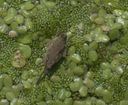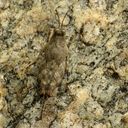Aztec Pygmy Grasshopper
Paratettix aztecus
Classification
- Phylum: Arthropoda
- Subphylum: Hexapoda
- Class: Insecta
- Order: Orthoptera
- Suborder: Caelifera
- Family: Tetrigidae
- Subfamily: Tetriginae
- Genus: Paratettix
- Species: aztecus
Pronunciation
How to pronounce Paratettix aztecus: //ˌpærəˈtɛtɪks æzˈtiːkəs//
These audio files are automatically generated. While they are not always 100% accurate, they are a good starting point.
Images






Summary
Paratettix aztecus, commonly known as the Aztec pygmy grasshopper, is a small species endemic to the southwestern United States and parts of Central and South America, recognized for its unique morphology and ecological niche as an herbivore in grassy habitats.
Physical Characteristics
Small size, with a characteristic flattened body shape typical of pygmy grasshoppers.
Identification Tips
Look for a small, slender body and the distinctive shape of pygmy grasshoppers; coloration can vary but typically includes shades of green and brown for camouflage.
Habitat
Prefers grassy areas, open fields, and sometimes arid or semi-arid regions.
Distribution
Found mainly in Central America and North America, particularly in the southwestern United States.
Diet
Herbivorous, feeding primarily on grass and other herbaceous plants.
Life Cycle
Undergoes incomplete metamorphosis; the life cycle consists of egg, nymph, and adult stages without a pupal stage.
Reproduction
Mating occurs during the warm months; females lay eggs in soil or vegetation, with nymphs emerging after a few weeks.
Predators
Birds, spiders, and other insectivorous animals may prey on P. aztecus.
Ecosystem Role
As herbivores, they play an important role in the food web and contribute to plant community dynamics.
Similar Taxa
- Other species within the Tetrigidae family
- Other pygmy grasshoppers
Misconceptions
Often mistaken for other grasshopper species due to size and shape; may be overlooked due to small stature.
Tags
- Orthoptera
- Insecta
- Tetrigidae
- Grasshopper
- Pygmy Grasshopper